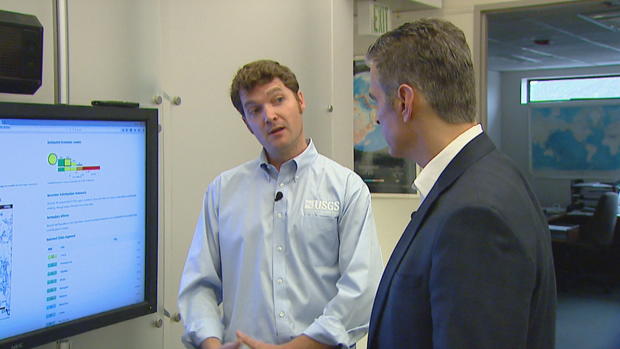The USGS's Other Earthquake Measurement
By Alan Gionet
GOLDEN, Colo. (CBS4)- It's a complicated formula for calculating the severity of earthquakes. But we get it… kind of. Still, it has generally served us well: 5.4, 6.2, 8.0, 9.1. You get the point.
"Magnitude is not a good predictor of damage," said the USGS's scientist in charge, Dr. Harley Benz.
But the media continues to pass along numbers from the USGS variation of the Richter scale called the "Moment Magnitude Scale" to convey an earthquake's power because frankly, it's something we all know. There is the whole issue of it increasing in magnitude exponentially (6.0 is not a tenth greater than 5.0, it's actually over 30 times stronger – 7.0 is actually a thousand times stronger than 5.0).
The killer earthquake this week in Italy registered a 6.2. The USGS reported one the same day in Myanmar at 6.8. The one in Myanmar hit a more populated area. Which one caused more damage and fatalities? Italy. That's because the earthquake in Myanmar was far deeper.
"In this part of Italy, earthquakes are shallow," said Benz.
There are all kinds of ways to describe earthquakes. The big earthquake in Alaska in 1964, which was a magnitude of 9.2, was said to be as powerful as millions of atomic bombs. That's not really a great yardstick, since earthquakes don't blow things up. We know with the moment magnitude scale that something over 7.0 is starting to get big. That's about all.
The USGS also has something called the "Modified Mercalli Scale." It measures shaking. The maps available on the USGS website show colored lines around epicenters that show shaking. The scale is in Roman numerals I through X.
"The different lines are the intensity of the shaking, so when you have these orange lines that means intensity, very severe shaking that would have been felt, people would have had difficult standing up," said seismologist Dr. Gavin Hayes about the earthquake in Italy.
It had orange lines around the worst hit areas, showing a level eight of shaking. That is considered "severe." A map of the earthquake in Myanmar showed shaking at a level five, considered, "moderate" (after review.)
Level one is "not felt," level 10 is "extreme."
"These intensities are a better measure of how the ground shook," said Benz.
They aren't the only data released by the USGS. They also release a "pager" which includes a mixture of the shaking, population density and the types of structures. On that page, the USGS noted in almost right away after the Tuesday earthquake that it estimated fatalities would be between 100 and 1,000, and the amount of economic loss would likely be between one billion and 10 billion.
We are still a long way from predicting earthquakes, but we're now closer to a better measurement of their strength.
Alan Gionet is anchor of the CBS4 Morning News and reports on a wide variety of issues and "Good Question" stories. He started at CBS4 in 1994. Follow Alan on Twitter @AlanGTV.





